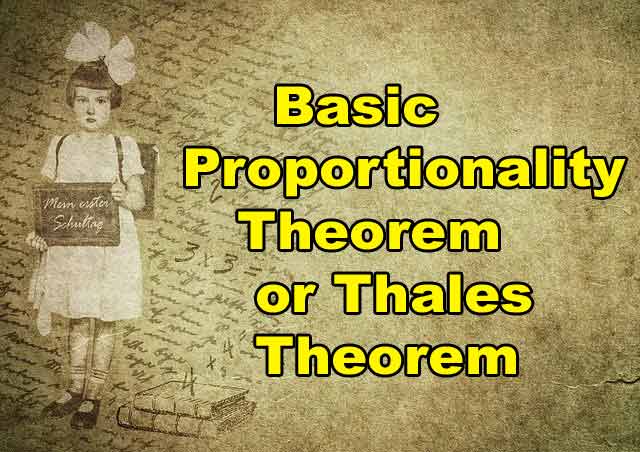Basic Proportionality Theorem or Thales Theorem
It states that if a line is drawn parallel to one side of a triangle, intersect the other two sides at distinct points, then it divides the lines in the same ratio.
In order to understand this theorem through pictorial representation, let us consider a triangle, say △ABC in which line m parallel to side BC passes through the sides AB and AC intersecting the sides AB and AC at two distinct points D and E.

So, in accordance with Basic Proportionality Theorem (BPT) or Thales Theorem,
In △ABC, if we have
DE ∥ BC

Proof of the Theorem:

In order to prove Basic Proportionality Theorem (BPT) or Thales Theorem, let us consider a triangle, say △ABC in which line m parallel to side BC passes through the sides AB and AC intersecting the sides AB and AC at two distinct points D and E
Let us draw DH ⊥ AE (or AC) and
EI ⊥ AD (or AB)
From the figure, we have
△BDE and △CDE are on the same base DE and between same parallel lines (DE ∥ BC)
∴ ar (△BDE) = ar (△CDE) ————–(i)
[Triangles on the same base and between same parallel lines are equal in areas)


From (ii) and (iii), we get

Hence, Proved
Converse of Basic Proportionality Theorem or Thales Theorem
It states that, if a line passes through any one point of a side of a triangle, intersects the other side and divides the two sides in the same ratio then the line is parallel to third side.
In order to understand this theorem through pictorial representation, let us consider a triangle, say △ABC in which line m passes through point D of the side AB and intersect the side AC at E, such that
![]()

then, DE ∥ BC
Proof of the Theorem:
In order to prove the Converse of Basic Proportionality Theorem (BPT) or Thales Theorem, let us consider a triangle, say △ABC in which line m passes through the point D of side AB and intersect the side AC at E such that

Let us suppose that line m is not parallel to BC
Then, through D, we will draw a line p parallel to BC intersect the side AC at F

Now, by construction, we have
What are parallel lines? | Properties of Transversal of Parallel Lines
DF ∥ BC
So, in accordance with Basic Proportionality Theorem, we have

From (i) and (ii) we get

Adding 1 both sides, we get

It is possible only when point F and point E coincides on each other and then we can say
“line m is parallel to BC”
DE ∥ BC
However, if it is impossible, then it means that our supposition “that line m is not parallel to BC” is WRONG
Hence, It is well proved that line m is parallel to BC
DE ∥ BC






7 thoughts on “Basic Proportionality Theorem or Thales Theorem”